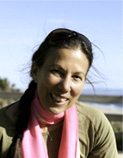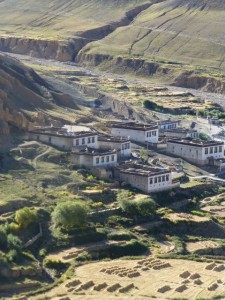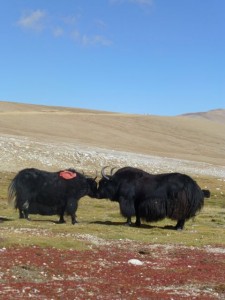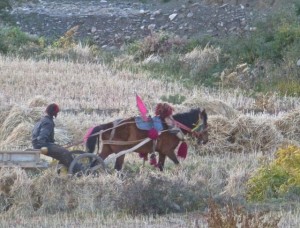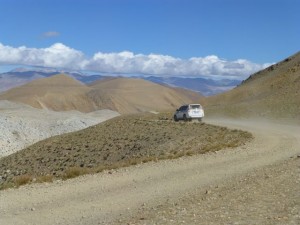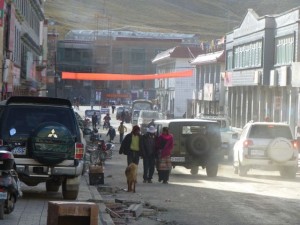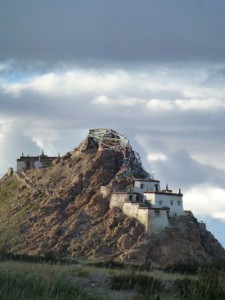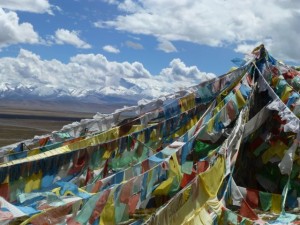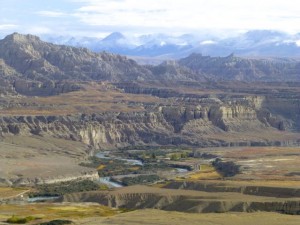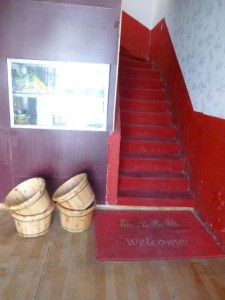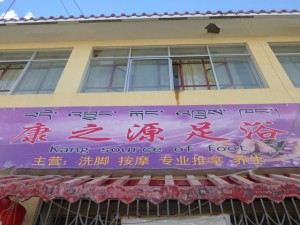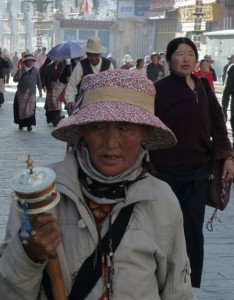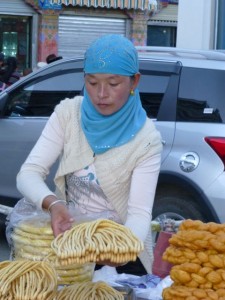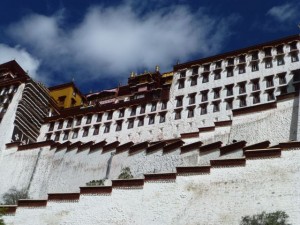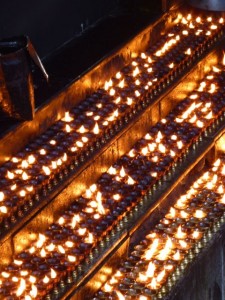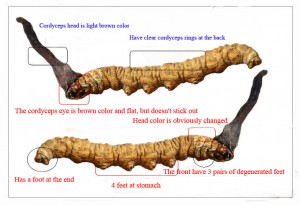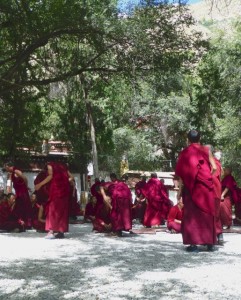How to bring you here, to share this experience with me. Ordinarily I have a good story to recount, a funny experience, an odd encounter, that brings to life the otherness of where I am. But what do I do when I’ve been in a different world, one for which there are no GPS points relating to my normal life nor to anything I’ve seen or done before.
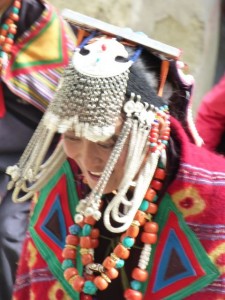
This has been a trip of landscape more so than people, unless you count yaks as people, in which case there’s been a lot of that. The Tibetan Plateau has me awestruck. For days we have been traversing plains of curry and cinnamon velour, stretching for a hundred miles without a bump. At a continuous altitude of 15,500 feet we are high above tree line, yet still, thankfully, below snow line. When I’m out of the car, the sun beats intensely on my skin, but the wind blows strong, with sharp edges that carry a chill.
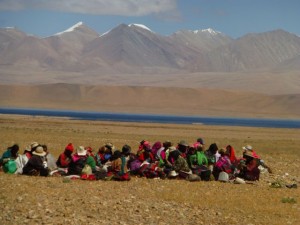
At the edges of these plains the velour carpet thrusts up with an abruptness that defies geologic creation of the volcanic sort. These are crumpled hills, like the earth making a fist that is all bare knuckles. They rise another 3,000 feet or more in colors of clove and bittersweet chocolate, some rocky, some softly carpeted in low grasses. The boundary between plain and hill is so startlingly it’s as if they say, “And you thought that was high! Wait till you see this!!” And still those hilltops, which in my beloved Colorado would overtop even the highest peak, taper off below snow line.
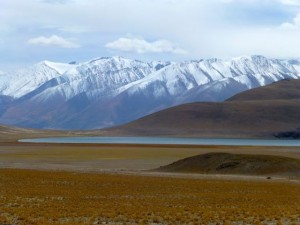
As we jar along on jaggedly rocky tracks, the road chances to swoop in a mile-long curve, and then mountains appear. We’ve driven on the north side of some of the most storied peaks in Himalayan mountaineering lore. As we left holy Lake Manasarovar and Mt. Kailash, the monumental summit of Nanda Devi stood head and shoulders above all nearby peaks, her white cliffs blushing pink in the first rays of a late dawn.
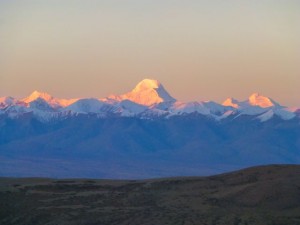
Day after day in the high reaches of the Tibetan Plateau, the snow line sinks. When I emerge from the guest house where we’ve slept the night (more on that in a minute) the confectioner sugar that sprinkled the higher peaks has changed to a thick whipped cream covering, and the white sprinkling is now lower on the mountain flanks.
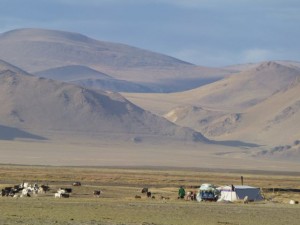
This plateau we are traversing is the highest in the world and arid to the point of receiving less than a few inches rain a year. Yet it is lake country in the finest sense, with both fresh and salt water lakes created when two continental plates smashed together, forming the Himalayan range and creating basins that trap snowmelt and rivers into lakes of a passionate turquoise and aqua color. Four of the ten highest lakes in the world are in Tibet, at altitudes that puts Lake Titicaca (12, 464 feet) to shame.
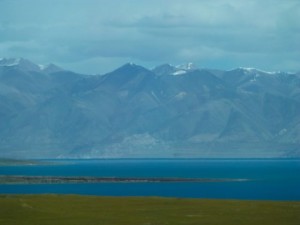
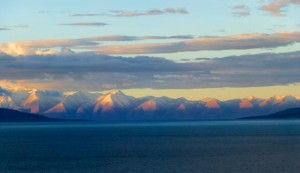
During the day we progress slowly, averaging 35mph only at the best of times. I had expected to pass through small villages, places to which herders of those aforementioned yaks would retreat during the depths of winter. But there are none, at least not real ones. Once or twice a day we pass through China-made facsimiles, with a half-mile strip of concrete for a Main Street and solar-powered street lights illuminating the packs of furry black dogs that roam freely.
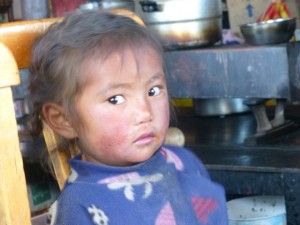
These are sad places, where village women sit on the ground, prayer wheels spinning, and young Tibetan men pass the time shooting pool on outdoor pool tables. In one or two there’s a cemetery of small stone chortens on the outskirts, evidence perhaps that there was once a bonafide Tibetan town here.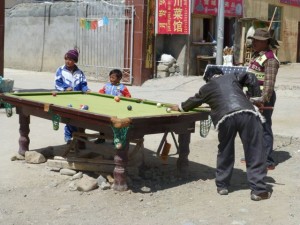
In the evenings, we eat in a local teahouse, sitting on carpeted wood benches around carved and painted low wood tables. A large tin kettle boils on a blackened steel stove in which a dung fire flares and dies. Whatever manure is at hand is used, whether little round goat pellets or chunks of yak droppings. The smoke has its own particular incense, a mix of moldy tobacco and wet cement, and it stings the back of my throat. 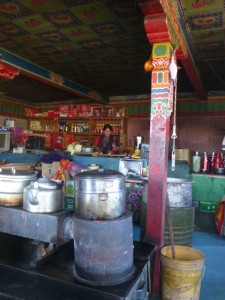 We make a meal of rice with a few plates of vegetables such as cauliflower, cabbage and bok choy. Sometimes there are curled snippets of yak meat in the dish. I scour each platter for those deadly red peppers and use my chopsticks to pick them out in advance. Our food is undoubtedly richer than what locals eat, but is lean nonetheless.
We make a meal of rice with a few plates of vegetables such as cauliflower, cabbage and bok choy. Sometimes there are curled snippets of yak meat in the dish. I scour each platter for those deadly red peppers and use my chopsticks to pick them out in advance. Our food is undoubtedly richer than what locals eat, but is lean nonetheless.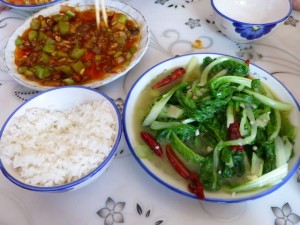
Dinner is our only meal, though I am grateful for the hardboiled egg I am able to get each morning. I have tried the thin rice gruel Tibetans eat in the morning, but it did nothing for me. Lunch usually is scrounged from our supplies in the back of the car: chocolate chip cookies, a big hunk of gouda donated to the expedition by Sabrina before she had to return to Hong Kong, salty crackers, chocolate bars And spam. Yes! Spam!!! This was Paul’s idea, who has a charming if incomprehensible attachment to the stuff from his childhood years. I declined spam the first week, but then hunger overcame my better judgment. The day I put a cracker with spam on it in my mouth was the day I tossed all culinary principles to the wind. All I could say as I chewed the bland, fatty stuff was, “Wish I had some cornichons.”
On the far reaches of the plateau, nestled beneath the towering hills, will be a solitary white tent, with a thin curl of smoke rising from the peak, the seasonal home of a nomad and his family, who tend not only yak, but herds of small white sheep and cashmere goats. 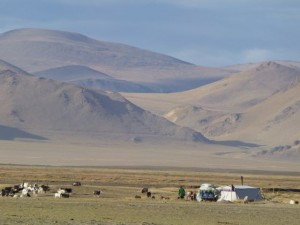 Now and then we cross paths with a man on an underpowered motorcycle handlebars decorated with green tassels, garlands of plastic flowers and lengths of prayer flags, seat covered in layers of carpet, wares piled high behind. It creeps along at barely faster than walking pace. The man wears his black hair in a long braid wound around his head with a scarlet cord. He’s in a thick coat, sometimes lined with fur, knee length and cinched at the waist. His skin is darkly tanned, cheeks ruddy with cold and wind. We nod at each other as he passes, and raise a hand in a short greeting.
Now and then we cross paths with a man on an underpowered motorcycle handlebars decorated with green tassels, garlands of plastic flowers and lengths of prayer flags, seat covered in layers of carpet, wares piled high behind. It creeps along at barely faster than walking pace. The man wears his black hair in a long braid wound around his head with a scarlet cord. He’s in a thick coat, sometimes lined with fur, knee length and cinched at the waist. His skin is darkly tanned, cheeks ruddy with cold and wind. We nod at each other as he passes, and raise a hand in a short greeting.

Despite the harsh climate we have seen wildlife : herds of wild donkeys, caramel colored with ivory legs; black-necked cranes which revered by Buddhists and breed on the Tibetan Plateau; Tibetan antelope and water deer, along with marmots (not quite like ours)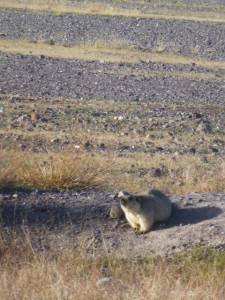
 and the same enormous lammergeier buzzards that we saw in Ethiopia. The lakes themselves, though, are strangely silent and empty. There’s no bird life around, which makes me think there no bugs on the shore nor fish in these high waters. But how could that be?
and the same enormous lammergeier buzzards that we saw in Ethiopia. The lakes themselves, though, are strangely silent and empty. There’s no bird life around, which makes me think there no bugs on the shore nor fish in these high waters. But how could that be?
We did pass through one village whose narrow streets, personalized houses and sense of age struck us all as the first and only authentically real Tibetan village on this trip. 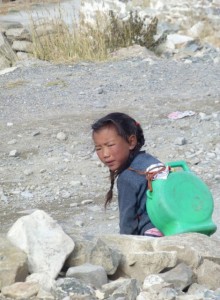 This was the village of Ombu, where one of the last remaining Tibetan monasteries also still functions. We’ve been in other monasteries on this trip, but all of them were simply shells, with a handful of monks retained to let in visitors, as compared to the sometimes thousands that used to reside in them prior to 1959. In Ombu the sense of permanence was still there, and I know I breathed a sigh of relief to be in a place that was legitimately alive with its own sense of history and purpose, rather than being an artificial implant.
This was the village of Ombu, where one of the last remaining Tibetan monasteries also still functions. We’ve been in other monasteries on this trip, but all of them were simply shells, with a handful of monks retained to let in visitors, as compared to the sometimes thousands that used to reside in them prior to 1959. In Ombu the sense of permanence was still there, and I know I breathed a sigh of relief to be in a place that was legitimately alive with its own sense of history and purpose, rather than being an artificial implant.
Which brings me to the most lasting impression from our traverse of the plateau: a sense of a people and culture vanishing before my eyes. Of standing on the edge of what was and seeing it fade into history, a ghost of what used to be. Of derelict towns, built in a Disneyland caricature of Tibetan architecture, populated by Chinese shopkeepers, with Tibetan nomads wandering the dirty streets, devoid of livestock. OK, I know I saw only a fraction of the country, and I know my impressions are based on a superficial view and not in-depths analysis. Still, I couldn’t help feeling as we drove along that all those garlands of prayer flags whipping in the wind were waving good-bye.
